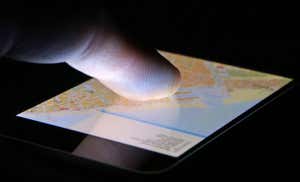

Your fingers take time to engage in full contact with a touchscreen. In some cases, even 30 seconds or more after placing a dry finger on the glass, your skin is still adjusting. This can lead to problems using fingerprints to access phones and getting screens to respond to your touch.
Michael Adams and Brygida Dzidek at the University of Birmingham, UK, and their team had two volunteers press a washed and dried index finger against a glass surface with increasing force. After 2 seconds, very little of the fingerprint was actually in direct contact with the glass. After a while, more of the fingerprint made contact. In most cases, the entire fingerprint was visible on the glass after about 30 seconds.
The keratin in the outer layer of our skin is inflexible when dry. This means that when you first push a finger against the screen of a smartphone, only the high points of your fingerprint come into contact with it. But fingertips start to sweat quickly.
The skin absorbs the moisture, making the keratin more flexible, allowing your finger to make full contact. “Most of us have ignored the effect of time when doing our own research on fingerprints,” says Roland Ennos at the University of Hull, UK.
Next-generation touchscreens are already being designed to use ultrasonic vibrations that give the illusion that smooth glass has texture. The screen can be made to feel smoother or rougher by varying the frequency of vibration when you touch particular parts of it.
The vibrations decrease the friction between skin and screen for a smoother glide, but they also mean a finger has only an intermittent contact with the glass.
This could lead to responsiveness problems, so Adams says developers may have to take his findings into account and make allowances for finger friction changes.
Source:- newscientist

